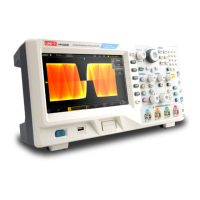
Do you have a question about the UNI-T UPO3000E Series and is the answer not in the manual?
| Brand | UNI-T |
|---|---|
| Model | UPO3000E Series |
| Category | Test Equipment |
| Language | English |
Details copyright, trademark, document version, and general product statements.
Explains terms and symbols used for safety warnings and precautions in the manual.
Covers checking for transport damage, attachments, and initial power-on procedures.
Describes the buttons, knobs, and interfaces located on the front of the oscilloscope.
Details the input/output ports and power connector on the rear of the oscilloscope.
Explains major control sections like Vertical, Horizontal, Trigger, Auto, Run/Stop, and Function Keys.
Explains the various indicators and display areas of the oscilloscope screen.
Guides on opening, activating channels, and setting coupling modes (DC, AC, Ground).
Explains adjusting VOLTS/DIV for vertical scale and enabling bandwidth limitation.
Details how to set the probe attenuation coefficient for accurate voltage readings.
Describes inverting waveform phase and applying bias voltage for signal observation.
Covers adjusting horizontal scale, ROLL mode, extended window, and independent time base.
Explains setting trigger hold-off time to observe complex waveforms like pulse trains.
Details sampling rate, memory depth, and acquisition modes (Normal, Peak, High Res, Envelope, Average).
Explains waveform distortion, aliasing, and leakage due to low sampling rates.
Introduces trigger source, mode (Auto, Normal, Single), and coupling concepts.
Guides on setting up triggers based on rising, falling, or any edge of a signal.
Explains triggering based on the duration of positive or negative pulses.
Details triggering options for PAL, NTSC, and SECAM video signals.
Describes triggering based on the slope (rising or falling) of the signal.
Explains triggering on pulses that cross only one trigger level threshold.
Guides on triggering when signal edges cross specified high or low voltage levels.
Explains triggering based on the time difference between two signal edges.
Describes triggering when a signal interval exceeds a set timeout duration.
Explains triggering based on the duration of specified channel code patterns.
Guides on triggering for digital signals based on setup and hold times relative to clock edges.
Details triggering on the Nth edge after a specified idle time.
Explains triggering based on specific combinations of channel logic states (H, L, X).
Covers decoding RS232 asynchronous serial communication signals, including settings.
Details decoding I2C serial communication, including SDA/SCL sources and address modes.
Explains decoding USB signals, including speed and trigger conditions for various packet types.
Guides on decoding CAN serial communication, including signal types and trigger conditions.
Covers decoding SPI synchronous serial peripheral interface signals and settings.
Explains performing addition, subtraction, multiplication, and division on waveforms.
Covers Fast Fourier Transform for converting time-domain to frequency-domain signals.
Details performing AND, OR, NOT, XOR logic operations on waveform data.
Explains applying low-pass, high-pass, band-pass, and band-stop digital filters.
Covers logarithmic, trigonometric, integral, and differential operations on waveforms.
Covers display type (vector/point), format (YT/XY), grid, and waveform brightness settings.
Explains using XY mode to display Lissajous figures for phase difference analysis.
Describes using color temperature to reflect waveform signal occurrence probability.
Introduces the oscilloscope's ability to automatically measure 34 types of waveform parameters.
Guides on accessing and using the automatic measurement functions and menus.
Explains how to select and display custom sets of measured parameters.
Details using cursors to measure time intervals and frequency on waveforms.
Explains using cursors to measure voltage levels and differences on waveforms.
Covers saving and recalling the oscilloscope's configuration settings to/from internal or USB storage.
Details saving and loading waveform data to/from internal or USB storage devices.
Explains how to capture the current screen display and save it to a USB storage device.
Covers self-correcting, system information, language, and menu display settings.
Guides on recording, stopping, and playing back waveform data.
Explains setting up and performing tests to check if signals meet template requirements.
Provides steps for upgrading the oscilloscope's firmware using a USB disk.
Explains automatic adjustment of time base, amplitude, and trigger for signal display.
Describes how to start and stop the waveform acquisition process.
Details restoring the oscilloscope to its original factory default settings.
Lists and explains common system messages and prompts encountered during operation.
Provides solutions for common problems like no display, unstable waveforms, or incorrect measurements.
Details input coupling, impedance, probe attenuation, and maximum voltage.
Lists analog bandwidth, rise time, resolution, scale, and bandwidth limit.
Covers timing scale, accuracy, capture rate, sampling modes, and memory depth.
Details trigger modes, hold-off, suppression, sensitivity, and various trigger types.
Lists specifications for RS232, I2C, USB, CAN, and SPI protocol decoding.
Covers cursor, automatic measurements, and mathematical operation specifications.
Lists display type, resolution, color, duration, and interface options.
Details probe compensation signal output voltage and frequency.
Covers power supply voltage, frequency, fuse, temperature, humidity, and altitude ranges.
Lists the size, weight, and calibration interval of the oscilloscope.
Lists standard accessories and optional items supplied with the oscilloscope.
Provides instructions for general maintenance and cleaning of the oscilloscope and probes.
Outlines the warranty coverage, repair, and contact procedures for service.
Provides contact details for UNI-T support and dealers for assistance.